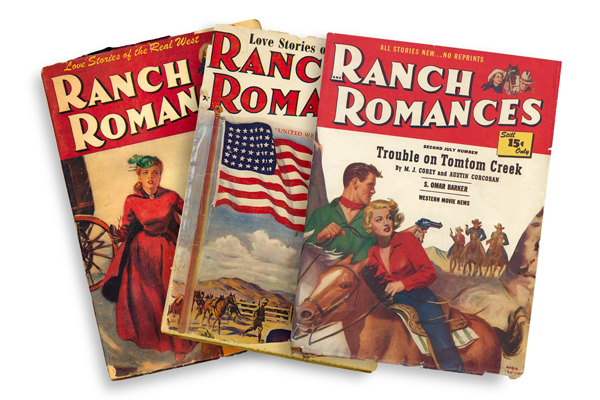 It started in 1924. He was the strong, silent type, with more than a hint of danger in the way he carried himself. His cowboy hat dipped at a rakish angle; his gunbelt comfortably wrapped around his slim waist. His past was a mystery; his future unknown.
It started in 1924. He was the strong, silent type, with more than a hint of danger in the way he carried himself. His cowboy hat dipped at a rakish angle; his gunbelt comfortably wrapped around his slim waist. His past was a mystery; his future unknown.
She was a rancher’s daughter, at ease on a cow pony’s back or on a ballroom floor. Folks said she had a will of her own, and most thought she’d never be tamed. Yet every time she was in his presence, the breath caught in her throat, her mouth went dry and her body shook ever so slightly—perhaps from nervousness, or desire or both.
And thus it went for nearly 50 years.
Nah, not their romance. America’s passion for a pulp magazine that mixed Western stories with romance novels, a veritable lust in the dust. The magazine was called Ranch Romances.
Over the years, there were a lot of imitators such as Rangeland Love Stories, Real Western Romances and Rodeo Romances. Most came and went after just a few issues. The original continued until 1971, well after pulp magazines had pretty much ridden into the sunset.
The pulps got their start in the 1910s, although some say they date back to the 1890s or so. Westerns were early favorites, especially tall tales about real folks such as Jesse James, Billy the Kid and Buffalo Bill. In the 1920s, William Clayton was looking to build a publishing empire. That meant doing something a bit different. One of his magazines was Astounding Stories, the first real Science Fiction pulp. And when Clayton got together with Harold Hersey, the two came up with the idea for a mag that might appeal to men and women alike—the result was Ranch Romances. Both guys went on to other things: Clayton was a better idea man than businessman, and he went bankrupt in the early 1930s; Hersey started some stellar offerings such as Strange Suicides and Medical Horrors.
But there was glue holding Ranch Romances together—and her name was Fanny Ellsworth. She was hired as the magazine’s first editor in 1924, and she continued in the job for nearly 30 years. One colleague called her “erudite” and said “she knew what she wanted.” And what Ellsworth wanted was what the public wanted—Western adventures with a softness, an emotional approach that other magazines lacked.
She also had an eye for talent. Elmer Kelton’s first published piece was in Ranch Romances. Other durable Western fiction writers, including Walt Coburn and Max Brand, sent their work to Ellsworth. Why not? The pay was good and so was the exposure—in the 1930s, the magazine generally had a circulation of more than 200,000 per issue. Lots of folks, of every race and creed and socio-economic level, read the pulps.
In the 1950s, publishers saw readership dramatically drop off. The advent of television was partly at fault. Movies took a growing chunk of the audience, too. More than likely, the very nature of the pulps seemed a bit ridiculous after the stark realities of WWII, so media companies began putting their money into other areas. The pulps dropped like so many bad guys did in front of Marshal Dillon’s revolvers. Ellsworth took her leave from Ranch Romances, pursuing other interests in books and magazines.
But Ranch Romances refused to die. New owners came in and brought new editors. They cut back on the number of issues, going from monthly to quarterly. By 1967, the magazine was nothing more than reprints of past articles. Still, it hung on until 1971 when the ball was finally closed.
Today, old copies are readily available, usually costing less than a buck per copy. There’s more demand for other, scarcer titles. The “heaving bosoms/muscular embrace” stories seem more than a little dated—and they sure don’t get the blood going the way they used to.
But for an amazing 47 years, Ranch Romances did set hearts aflutter and fired the passionate dreams of would-be cowboys and cowgirls. That’s a legacy that stands tall and proud, with a passion that smolders like a campfire on a clear and crisp Western night.
Elmer Kelton’s first story, “There’s Always Another Chance,” appeared in the April 2, 1948, issue of Ranch Romances, and it is available as a . It was the first of 34 short stories, articles and novelettes that Kelton sold to the publication.
Now a seven-time Spur Award winner, Kelton shares with us his memories of writing for Ranch Romances: “Its editor through most of that time was Fanny Ellsworth. When I was first starting to write stories, she would reject what I sent her, but she soon began writing short letters of encouragement, telling me why the stories did not work for her and urging me to keep trying. Ultimately, she bought that story [“There’s Always Another Chance”]. A year later, she bought another. From then on, we had a fine relationship (all by mail) until she retired. By then, I am sure she saw the handwriting on the wall as pulp magazines were fading out of the picture. I have always been grateful to her for giving me my start, as she did for many other beginning writers. I owe much of my career to three women editors: Fanny Ellsworth, Betty Ballantine and Judy Alter of Texas Christian University Press.”
Elmer Kelton’s novel, The Raiders: Sons of Texas, was recently published by Forge Books. His short story, “There’s Always Another Chance,” is included in the same-titled short story collection published by Fort Concho Museum Press. You can order copies by calling 325-481-2646.






